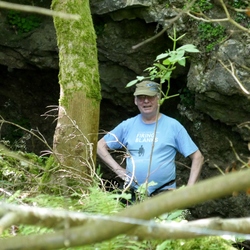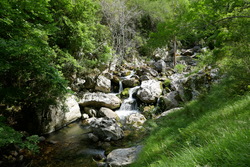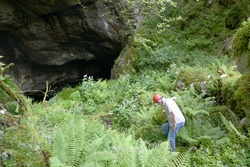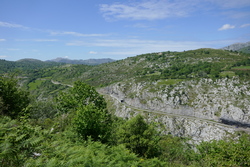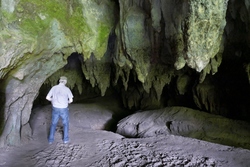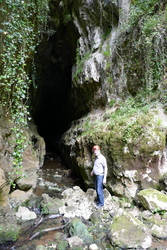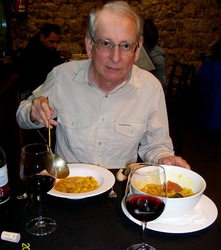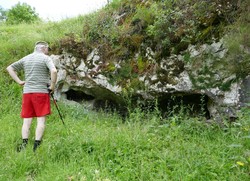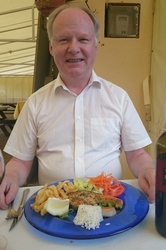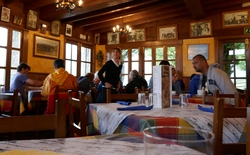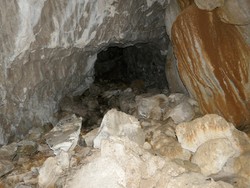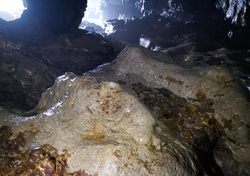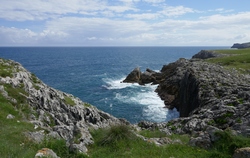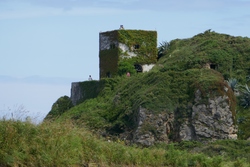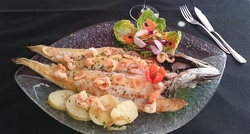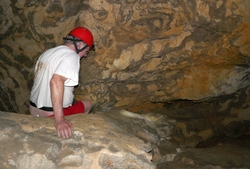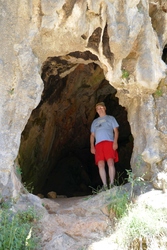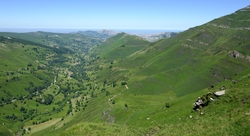

Introduction
Site list (GPS fixes) Walks (GPS tracks) Video clips Panoramas
Electronic projects:
Bat detector
Lamp tests
µ-controlled lamp
SEPIC-based lamp
ISP isolators
Making SMT boards
Expedition logs:
Spain 1973, 1974,
1975, 1976, 1977,
1979, 1982, 1983,
1985, 1986, 1987,
1988, 1989, 2000,
2001, 2002, 2003,
2004, 2005, 2006,
2007, 2008, 2009,
2010, 2011, 2012,
2013, 2014, 2015,
2016, 2017, 2018,
2019, 2020, 2021,
2022, 2023
Mexico
New England
Translation:
Expedition log, Summer 2016
Cicera, Trumbio, Cobijeru, Vega de Hibeo, Toyu.
Click on, or tap any image thumbnail for a full-size version, or on a video clip to play at a larger size.
| Date | Activity |
|---|---|
| 07.06 | Bill leaves home at midday and drives 200 km to Bergamo. Flight on time and arrives at
Santander early 19:20. Collects car, phones hotel to advise after-midnight
arrival and seeks advice on where to eat nearby at tourist kiosk
in the airport. Mike passes the arrivals exit at 22:05 and we proceed
(as recommended) to Liencres where we end up at a rather unpretentious
Bar Casa Carlos. But the food was remarkably good – and we were
hungry. Lomo for Mike, and jamón for Bill plus good chips
all washed down with Ribera del Duero.
Arrive at Llanes around 00:45 and after a quick walk round the town we checked into the Montemar Hotel. |
| 08.06 | Walked into town in search of breakfast and settled on the Xana bar by the estuary for
café con leche and an enormous slice of tortilla. The weather
was overcast and the Sierra de Cuera was hidden behind the clouds.
So a drive south was planned, but near Puente Nuevo the sky had cleared
and we decided to drive up to El Mazuco. Parked at the paddock
beyond the village and contoured round towards Ojo del Río. Very
low water levels and the cave entrance was more exposed, but the
entrance pool prevented inspection of the passage.
We proceeded up a steeper path climbing over walls and barbed wire reaching the Vega del Cubo which is a large closed valley with some sub-depressions. On the south side is a cliff face and cave entrance (Collau Rubiera, GPS’d in 2004). It appeared to go but we were not prepared for a flat-out crawl. Besides, the prospect of lunch at El Roxin tempted us back to El Mazuco. For a first day’s walk we were fairly satisfied. We ordered chorizo, criollo and patatas ali-oli (just 3 plates) but we couldn’t finish the excellent food. After a drink in “El Sucon” we returned to Llanes via Posada. For dinner we shared a plate of cheeses at ‘La Amistad’ but we couldn’t finish that either! |
| 09.06 | Grey drizzle in Llanes, so our automated response – head South – kicked
in. With the new motorway to Unquera open we were in La Hermida
in 45 minutes! As predicted we had left the clouds behind and we
were soon enjoying some picón (queso de Bejes)
in the sun outside Posada La Cuadrona.
Our objective for the morning was to walk up the Riega Cicera valley from the Gorge to the village of Cicera. After some to-ing and fro-ing to find a parking space (at altitude 170m), we started up the track which was surprisingly steep in places. Fortunately the day wasn’t particularly hot, and the path was often shaded by fig trees, etc., but even so we were very pleased to find a bar when we got to the village, at altitude 500m! Descent was much faster, for a total walk time of 2:45 (track), and we arrived back in La Hermida a little after 3pm – in time for lunch (sopa and escalope). Back to Llanes via Urdón and along the Cares Gorge, stopping at La Molinuca at the road leading to Cueva Llónin, etc. Shared a dish of Fritos de Pixin at Rte. Salero, for dinner. |
| 10.06 | After the previous day’s walk we were feeling that more caving and less walking might be in order,
and as yet again the skies were overcast we planned on Cueva del Trumbio. The big cave is notionally only 10 minutes from
the road south of Covadonga to the lakes. However a previous attempt
in 2012 had failed as the entrance depression had been completely
overgrown by gorse.
Perhaps in previous decades, the gorse was kept under control by cows but EU policy has been to reduce the butter mountain by reducing the dairy industry. This has had the side effect of making cave entrances less accessible! To add to the obstacles the access field was very wet and muddy and protected by barbed wire. Bill managed to lacerate a finger as a branch he was holding on to turned out to be rotten. (Nothing too serious, a clean wound.) Within sight of the entrance, we attempted a direct descent but soon found ourselves surrounded by gorse and above a vertical cliff face. Frustrated, we retrace our steps to the track and walked away from the cave towards a llosa (meadow). At this point we were at stream level (no water). The mossy rocks looked pretty treacherous so instead of following the steep streamway we contoured along on the far (southern) bank in the woods. No gorse here but plenty of holly trees! And mud on the steep path. Bill managed to fall over and the second time got rather dirty! However this new route worked and we got to the entrance. Honour satisfied and after a few photos we retraced our steps. The llosa did not reveal anything of speleological interest but is full of little sinks. As we walked up through the gorse there was some slight drizzle; welcome, as we were warm from our exertions. Lunch in Casa Morán, Benia, recommended for its excellent fabada, followed by lamb. Good quality food for a menú del día but pricey at €38 for 2 including Ribera del Duero. Back to Llanes via Posada and autovía. Dinner at El Almacén, bocarte (fresh anchovies) for Mike and boletus mushrooms in Picón cheese sauce for Bill. |
| 11.06 | Glorious weather, sun with some cloud, 20°C. As it was Saturday
we decided to avoid busy places such as the Lakes or Bulnes, and
headed to Tielve to reconnoitre possible tracks towards Valfrío,
to start us up towards the Majada de Tordín. A steep concrete
track led invitingly NE from the village, but it was exceptionally
steep and very soon the rental car declined to proceed further.
A complicated team effort succeeded in executing a multi-point turn
and a safe descent.
We decided the weather was ideal for a walk above Sotres, and headed East. At the hairpin bend junction below Sotres, however, was a large coach, blocked by cars parked on the bend. Unable to go up, we turned off and went a short way along the track towards Áliva to turn, seeing a number of tired runners and spectators. After many dusty hill starts, etc., we made it back to the hairpin bend and were able to depart down the hill. Meanwhile a stream of vehicles – and a second coach – were joining the long queue that was trying to get up the hill. Very relieved to have open road, we returned to Arenas where we discovered we had stumbled onto the final stages of the Travesera de Picos De Europa, a 74km(!) run that started in Covadonga at midnight and whose first runner arrived in Arenas as we were there, 13 hours later. It now being lunchtime, we carried on to Mestas de Con for a welcome menú del día. Thus fortified, and a bit frustrated after the morning’s difficulties, we backtracked to Berodia to explore the limestone behind the cave at La Foz that we had often noticed from the Arenas–Ortiguero road. An enjoyable walk covered the area to our satisfaction, although no significant speleology was found. Back via Rales, but did not meet any of our old friends. |
| 12.06 | A bright day but rain forecast. After breakfast at Bitacora, drove east towards Buelna on the old autovía
and stopped briefly near Pendueles after noticing some entrances
north of the road 📌. They may
be real caves but are clearly used by the local farmer and his animals
so were not accessible.
On to Buelna to look at another inland beach (connected to the sea only by a sea cave). We arrived by car and on foot from the north; realized this was not the best approach and reversed our path back to the N634, parked there, and followed the tourist signs to Cobijeru. A very pleasant walk through meadow and wood, and to our delight we found a stream emerging from an enterable cave 📌. The same stream sinks in a much larger entrance further on 📌 and we walked in. The stream meanders off to the right and a larger high level but muddy passage continues on the left. We did not look for the resurgence to this system but so near the sea it is likely to be close by and defended by undergrowth. Another 4 minutes walk brought us to the Cobijeru inland beach, almost exactly at high tide. To the east, some 4m above sea level, there was another entrance 📌 which Bill entered using a torch. Initially it was necessary to stoop but after 20m bigger walking passage was reached with real cave complete with stal. Bill called back gleefully “It goes” and continued out of sight of daylight. The sea could be heard and soon seen via multiple entrances at water level connected to a large chamber. Bill returned to call Mike and both briefly explored. A satisfactory little through trip – about 70m long. Next stop was the sink cave at Cobijón village which we found in 2014. This is a fine vadose entrance 📌 10m high and 3m wide taking water (and no doubt refuse from the village). Neither of us were prepared to paddle down the passage (there was no dry land) so this cave will have to wait. Later googling failed to reveal clear details of exploration but the cave is well known to the locals. We had an excellent menú del día at “Restaurante Las Filipinas” in Comillas followed by a detour to Camijanes on the way back to Llanes. |
| 13.06 | Despite a poor forecast and ominous clouds, the sun came out and we
headed to the village of Póo de Arenas (1.7km WNW of Arenas).
After crossing the river, tracks to the west zigzag up the side of
Peña del Alba, which has inviting cave entrances in its cliff faces.
In 1975, Bill and Steve Newton found a cave possibly near there.
No such luck in 2016, although a very pleasant walk was had, with
wildflowers, butterflies, and lizards in abundance.
On to Mestas de Con for refreshment, then to Cangas for lunch – which we expected to be quiet on a Monday. Cangas, however, was chock-a-block with people and the main streets were closed for the procession of the Fiesta de San Antonio de Padua. Unable to continue and in a one-way street, we parked in a police-car rank and took some pictures. Once allowed to proceed, we decided that the restaurants in Cangas would be impossible, and headed to Ribadesella. What a contrast! A cold wind blew, the streets were deserted, and only 3 or 4 restaurants were open. Fortunately one (El Ancla) offered a menú del día that went down well (salad / fabada, escalopine al cabrales). Back to Llanes on the ‘old road’, getting another picture of the promising possible cave above the the Poligono Industrial. |
| 14.06 | Another sunny start, so off to explore a depression recently noticed on the map: Vega de Hibeo (track). Two km south of Meré, a narrow metalled track crosses Puente Cima Cosagre and hairpins up to Ilcedo. From there a pleasant and steadily ascending walk along a limestone boundary took us up a little over 200m in 2km and 1:20, reaching a grassy col overlooking the quite idyllic Vega, with grazing cattle and horses.
We followed the snaking stream to a promising limestone cliff 📌, with several holes and possible
caves, but none of them ‘went’. Back to the col, then down an easier
‘cow motorway’ we’d spotted earlier for the return downhill, which
took 52 minutes.
To El Sucón for menú del día, €9 each, of which the highlight was salmón a la plancha. Rain started while we were eating, and more arrived later in the afternoon, but it was beautiful walking weather in the morning. |
| 15.06 | First part of plan was a photo trip in Cobijeru cave at Buelna.
Drove there using the (deserted) old autovía and arrived just as
a coach disgorged dozens of schoolchildren, many of them wearing
helmets. We ‘pushed’ the muddy cave a little further, then carried
on to the main cave. As we feared, a mound of day-sacks (guarded
by a teacher) indicated that a large party had entered the cave.
We walked around the cliffs for a while, then a short foray into
the cave showed that it was thoroughly misted-up and photography
would be pointless.
On (via Unquera and Merodio) to Cueva Toyu to solve some questions about the survey (is the barn in the right place? etc.) by GPSing the top entrances. A helpful farmer pointed out our old nettle-filled favourite candidate and allowed us through his field to GPS it 📌; we also re-GPSed 📌 the infamous barn NE corner (extended in 2015). Unfortunately the electricity poles detailed in Peter Robertson’s 1982 sketch map are long gone, so we had to defer searching for the “Cueva Roza[da]” entrance. Asking the farmer about Cueva Rozada elicited an unexpected response: he directed us to a new (to us) cave entrance a few hundred metres north – GPSed it 📌 for future investigation. Key data secured, on to Camijanes for another above-average menú at Casa Gloria. Back in Llanes, analysis of the GPS readings and track conclusively showed that the ‘nettle entrance’ is not one of the top entrances to Toyu; instead it is the small feature, shown 120m SW of the barn on the plan and elevation of our 1982 Speleogroup survey, that we had overlooked. We also calculated predicted GPS positions for the ‘Cueva Roza’ entrance 📌 and the resurgence 📌. |
| 16.06 |
It had rained most of the night but a brief respite at 9am allowed
us to cross the road to have our breakfast café con leche.
On the way to the lakes we stopped for a second breakfast of Gamonéo
cheese in Mestas de Con and it continued raining all the way up to
Bar “María Rosa” (1100m) which was doing a brisk business of sheltering
tourists from the damp. We were recognized immediately by the waitress
and granddaughter of the bartender in 1975 whose photograph is on
the bar wall. Although it was only midday, we ordered 2 plates of
food and a glass of tinto. For nostalgia, Bill ordered a half ration
of queso semi-curado – similar to the white crumbly cheese we
used to eat 40 years before, when exploring
Forcau.
Our object had been to walk to to Vega de Comeya – a large flat depression – but the rain ensured we never ventured further than 30m from the car! It continued to rain until we got to Posada where we took the autovía back to Llanes. The rest of the afternoon was sunny (on the coast). |
| 17.06 | Rain, so south again. New route (motorway + Bustio) to La Hermida
brought the driving time down to 40 minutes. Still raining, so the
planned walk to create a ‘SampleGPX track’ for MapGazer » became a drive from La Hermida to Bejes (track). Then to Potes, where the rain finally stopped, to buy a
map, etc. Given the improvement in the weather and not feeling like
going further south, we backtracked and headed north and east via
La Fuente to
Toyu determined to locate the oriental (NE) upper entrance.
First approach (direct up from the road) didn’t work, and nor did the second (down from cart track above). However, the third (west from the cement track) was successful: Bill found the small cliff face and Mike confirmed a draughting cave. Mike descended to almost out-of-daylight and confirmed it was the Toyu entrance; its GPS position 📌 was within about 12m of that predicted, well within error bounds of GPS and the estimate. “Always carry a spare light” proved its value when Mike’s main lamp went – literally – on the blink. Well pleased, and with the wet weather blues firmly banished, we continued on to Casa Gloria for another pleasant menú. Back to Llanes via Pendueles. |
| 18.06 |
A bright morning. Off to Buelna to Cobijeru inland beach and its
cave for a more thorough exploration and wearing more appropriate
clothes and helmets. Low tide. We took photographs of the sea funneled
into the cave and creating a spectacular spray (and lots of noise!).
Noticed that the rocks in sight of daylight were often green or purple
which Bill attributed to salt-loving algae and photosynthetic bacteria.
The purple was more common in wetter zones. Some interesting ecology
going on.
After an hour underground we made some rough measurements of distance and bearings to be able to retrace our footsteps on the surface and found ourselves on the cliff above the lower entrances, 135m from the inland entrance. We had underestimated the length of the system, which we now guess to be at least 200m (rather than 70m). Drove west on the “new” autovía to Posada and on to El Mazuco descending the cement-surfaced track towards Bolugo sink. After the rain there was a lot of water and there were a number of distinct streams draining the depression. This also meant that the tracks were very muddy and slippery, but the undergrowth was mainly dry. Our object was to GPS the Boriza resurgence but access was inhibited by the difficult terrain, (woodland, brambles, bracken, mud, barbed wire). We probably arrived within 50m of the entrance before retracing our footsteps. We now had worked up quite an appetite, so lunch (chuletillas!) in Roxin and return to Llanes. |
| 19.06 |
Nice weather, and with caving planned for Monday we eventually decided
to have a closer look at the Pechón peninsular (NE of Unquera)
visited by Bill some years ago. The small white roads shown on the
map were drivable, and by luck we chose the right way around them
– it turned out they are a one-way system starting June 15. We
explored a closed depression, La Hoya (NE of Pechón), on foot.
Unfortunately
a house occupied the exact place we predicted a cave, leading us
to speculate that there was a cave there, leading down to a sea cave.
The western end of the peninsular proved to be inaccessible, so we retreated to Comillas for lunch; a reprise of 2014: spectacular pijota a la plancha (baby hake) and chiperones en su tinto at Casa La Aldea. |
| 20.06 | Welcomed by a bright blue sky we had a good breakfast at Cafeteria El Latino then drove east to Venta de Fresnedo for some caving in Toyu.
After changing, Mike GPSed 📌
the “Torca” behind the barn but did not descend as it was partially
filled with tree branches. We retraced our steps along the track
and turned south to the other top entrance through the gorse, brambles,
and nettles we had thrashed through on Friday.
Bill descended first wearing his bright red shorts which rapidly
became quite muddy as he insisted on chimneying down the easy entrance
climb. We were both soon in the dry large chamber with various passages
descending on the left, and some ascending on the right. This was
the cave we had not entered in 30 years!
After some difficulty route finding, we found our old route down via the second passage on the left. It seems some subsequent explorers (Carlos Puch?) had made little cairns of stones to mark the route. Nevertheless route finding was not easy but after 15 minutes we came to the climb marked as 5m on our 1982 survey. In those days this was an easy free climb (particularly when wearing rubber wetsuits). But 34 years later a hand line or ladder was thought necessary so we turned back to search for the “Torca” entrance and make a through trip. Back to the chamber ... but there were many possible passages to explore. We separated (remaining in voice contact) trying various routes and consulting the printed survey which Mike had thoughtfully taken underground. All to no avail. It looks like we will have to descend the Torca another year to make the through trip. Spent about 1 hour underground.Changed, and drove to Urdón to look at the famous (The Highlands of Cantabria, Ross & Stonehewer Cooper, 1885) cave entrance there 📌 about 30m from the Tresviso path and the main road. We had not visited it before, and it turned out to be just 5m long so we could not even get out of sight of daylight! It was now 14:00 so we drove back south to La Hermida and enjoyed their €12 menu del día. Back to Llanes via Posada. |
| 21.06 | Evening flights in effect allowed a full day of activity, but with
gear packed reconnaissance was in order. Anxious to re-sample the
lamb at Espinosa de los Monteros remembered from 2005
we chose a route via Torrelavega, Puente Viesgo, Vega de Pas, and
Pto. de las Estacas. On arrival at Vega de Pas, however, we found
the road over the pass closed for roadworks. Choosing the shorter
of two long options, we rerouted via Selaya and Portillo de Lunada
(1,350m). We were rewarded with spectacular views, limestone, and
even a little snow. Arriving in Espinosa on-schedule at 14:03, we
found (we think) the 2005 restaurant (Sancho García) in the main
square; hard to find as it was market day and the square was full
of stalls and vans. Lunch was exceptional for a menú (€10.50),
with paletilla (shoulderblade) of lamb being the highlight.
On to Ramales to see if it would make a suitable base for 2017 (on the to-do list because of trips there in 1977), but it didn’t inspire. Ditto for Laredo, after a ‘10 minute’ diversion to check it out. Next to Solares to fill tank, etc., before arrival at Santander airport – again on schedule at 18:30. A very full day, with lots of driving for Bill over quite exposed mountain roads. Bill made it home at 02:00, Mike got to Stansted hotel (after an hour in passport queue) at 01:00. |
Notes:
- Exchange rate: 1.26 (compared to 1.425 in 2015); 70p = 1 Euro = 166 pesetas (237 pts/GBP).
- Weather: A few damp mornings, but otherwise very pleasant – around 20°C most days.
- The pictures in this log were mostly taken using a Panasonic DMC-TZ100
camera; its stabilisation and 1″ sensor allowed the cave photographs
here to be taken hand-held and lit by the headlamps we were wearing.
Also used (in Cobijeru cave) was a Manfrotto Muse LED floodlight. - Specific GPS positions are shown by a pushpin symbol (📌) in the log above – click on the symbol for a Google maps view of the fix. These positions are also listed on the Speleogroup site list page with coordinates in °,′,″ degrees using WGS84 datum and in UTM coordinates; see Coordinate systems.
- Fixes and tracks were recorded using a Sony Xperia Z3 Compact Android ’phone using the MyTrails app.
- This log was almost entirely edited in the field on an ASUS T-100 ‘Transformer’ notebook, using the MemoWiki » extended Wiki notation which is then processed by a Rexx » script to generate the HTML for this web page.
